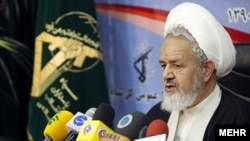The supreme leader’s representative to the Islamic Revolutionary Guards Corps (IRGC) has presented a list of Iran’s red lines in the region.
While insisting on the necessity of transferring the culture of Mobilized Forces or Basij to the region, mid-ranking cleric Ali Saeidi listed President Bashar al-Assad of Syria as one of Iran’s main red lines.
The Basij is one of the five forces of the IRGC. It is a paramilitary volunteer militia established in 1979 by order of the leader of the Islamic Revolution, Ayatollah Ruhollah Khomeini, who urged its originally civilian volunteer members (called “basiji”) to fight in the Iran-Iraq War (1980-1988).
According to Iran’s official news agency, IRNA, Saeidi said on September 14, “Defending the sanctuary of the House (of Prophet of Islam, Muhammad), keeping Syria in the Resistance Front, independence and territorial integrity, and keeping the person of Bashar al-Assad [in power] are Iran’s four red lines in Syria.”
Meanwhile, in a letter to Supreme Leader Ali Khamenei, al-Assad thanked Iran for its support to fight against “terrorism” and end Deir ez-Zur’s siege.
Moreover, al-Assad “congratulated Ayatollah Khamenei on the strategic achievements of the Syrian Army” and expressed his gratitude toward Iran for cooperating with this country to stand against “terrorism.”
The supreme leader’s representative to the IRGC also maintained, “[In the past] whenever America decided to make a change, it was always immediately done. Yet, for the past five years, it has been attempting to change the Syrian ruling system and separate it from the Resistance Front with no success.”
Furthermore, Saeidi claimed, “The Islamic Revolution had an impact not only on Iran but also on the regional and international level. Developments made in the region, including in Syria, are an example of the revolution’s impact through transferring basiji culture.”
Quoting Saeidi, Khabaronline reported, “The enemy attempted to separate Syria from the Resistance Front, whereas today, Iraq and Syria are at Islam’s service.”
Since the beginning of the civil unrest in Syria, Iran has hurried to support al-Assad and has since deployed its forces, along with hired Afghan and Pakistani forces, to fight against those seeking to overthrow Assad.
Although there are no independent and reliable statistics available on Iran’s casualties in Syria, it is estimated that more than 1,000 Iranians, including several IRGC commanders, have lost their lives there.
Iran alludes to its fighters in Syria as “defenders of the Shrine,” a highly controversial reference to the Sayyeda Zeinab mosque near Damascus, where a sister of the third Shi’ite Imam is said to be buried.
Iran’s armed intervention in Syria and the death of hundreds of thousands of Syrian civilians has deeply unsettled the Middle East, leading to unprecedented Shi’a-Sunni tensions.










